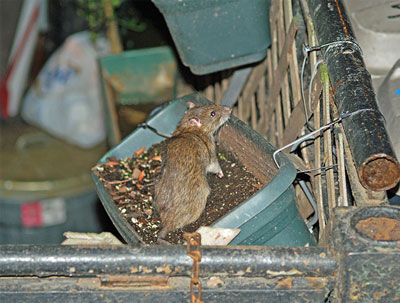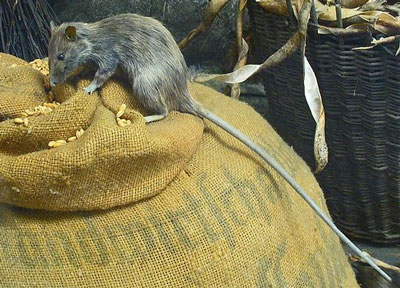Rats: no evolution!

The small animals we call rats come in two types, the black rat and the Norway rat (Rattus rattus and R. norvegicus), and they have lived with man throughout history. Usually dark animals with pointed noses and hairless feet and tails, they are similar to, but generally larger than, mice (both rats and mice are members of the order Rodentia).
Rats are aggressive, active, and adaptable, and they have accompanied man throughout the world, traveling on ships and boats of all sizes. They are able to breed at three to four months of age, and can produce up to seven litters a year, each containing six to 22 young. It is commonly believed the rat population of the United States is equal to the human population: more than 1,000 rats per acre were reported on one Iowa farm!
Given rats often carry disease—and can eat anything man can eat—it’s easy to understand how destructive these rodents can be. In rural areas, rats are a threat to seed and grain crops. Even after harvest, the rat continues to be a menace, not only eating the grain stored on farms, but also rendering it unsuitable for humans to eat because of its droppings. About 23 kilograms (50 pounds) of grain are required to support a rat for a year, but the total amount of grain loss (including spoilage) is about 70 kilograms (150 pounds) per rat per year.
The senses of rats are highly sophisticated, and their ability to climb, jump, burrow and gnaw gains them entry to places inaccessible to other mammals.
Despite the fear and loathing they often engender, wild rats play an important part in the biological economy of this fallen world. This is not only from their obvious role as scavengers, but as food sources for other creatures.
Like all other rodents, the rat spends a great deal of time gnawing, much of which serves simply to wear down the front incisors, which continuously grow at a rapid rate (upward from two millimeters, or 0.08 of an inch, per week). When gnawing, the rat’s lower jaw moves backward and forward, with the upper incisors holding the object while the lower incisors cut against it.

Encyclopædia Britannica describes rodents as being ‘relatively primitive’ in most aspects and ‘not highly specialized’ mammals, yet when discussing the specializations needed for gnawing, it states the gnawing mechanism is ‘of an efficiency that is not approached by that of any other mammals.’1
Encyclopædia Britannica claims the earliest known rodents come from the upper Paleocene (supposedly about 57 million years ago) of North America, yet it admits these animals ‘had already acquired all of the diagnostic features of the order.’ In other words, these ‘early’ animals were easily recognizable as rodents.
Comprising 50% of all mammal species, rodents should be prolific in the fossil record, and evolutionists should expect to find numerous examples of transitional species. However, Britannica states: ‘Rodents are relatively poorly represented in collections of fossils, in spite of their great abundance at the present time.’2 This situation is clarified with the explanation that rodents have often been ‘overlooked’ because of their small size, ‘but modern exploration for fossils usually results in a much more abundant representation of small mammals, especially rodents.’ The bottom line—there is no fossil evidence for the evolution of any rodent from a non-rodent.
Duane Gish, in his book Evolution: the fossils STILL say NO! agrees rodents should provide evolutionists with a group of animals ideal for evolutionary studies ‘given their enormous numbers and their ability to flourish under all conditions.’ Yet, he quotes evolutionist Romer as admitting the origin of rodents is ‘obscure,’ and that at their first appearance in the fossil record, they were already ‘true’ rodents.
Romer says: ‘Presumably, of course, they had arisen from some basal, insectivorous, placental stock, but no transitional forms are known.’3 Yet the lack of transitional evidence in the fossil record is easily understandable from the Genesis account of Creation, that God created all creatures to reproduce ‘after their kind.’
The two rat species mentioned earlier almost certainly descended from the same original kind. Rats may actually share ancestry in the same created kind as mice; the evidence clearly confirms, though, that they did not share a common ancestor with some non-rodent. All the genetic information for rats was brought into being six days after the beginning of everything. In other words, rats, like all other creatures, are not the product of evolution.

Rat bytes
In some countries, eating rats is a major source of protein for poor rural folk.
Rats have been known to kill several hundred baby chickens in a single night. Eggs are frequently eaten, and even full-grown hens, baby pigs and lambs may be killed by wild rats.
Laboratory rats are domesticated albino strains of the Norway rat.
While the black rat is an excellent climber and jumper, the Norway rat prefers to dig burrows (it is also an adept swimmer). When both species live in the same area, they occupy different habitats; in a building, the Norway rat tends to occupy the lower levels while the black rat lives on the upper floors!
The North American pack or trade rat is attracted by bright and shining objects, which it takes home to its nest. A popular superstition is that the animal is a fair ‘businessman,’ who, on seeing something he wants, always leaves some object as a replacement that, in his opinion, is of equal value. Actually, the reason the rat leaves something behind is simply so it can carry its new ‘treasure.’
Reference
- The Encyclopædia Britannica, (15th edition), 23:401–403, 406, 1992.
Rats and the Black Death

Undoubtedly, the rat is most infamous for its role in the spread of plague, both in the Middle Ages, and more recently, in heavily populated Third World countries. However, the rats themselves do not pass on the disease: rather, it is the fleas living on the rats which take the infection from rodent to human.
The epidemic of plague often referred to as the Black Death originated in Mesopotamia in the 11th century, spreading to Europe soon after. It reached its peak on the Continent in the 14th century, when some 25 million people are believed to have died as a result of infection.
Rats thrived in towns in the Middle Ages, where food scraps and other waste was usually dumped out of windows and onto the streets. Once infected with the plague, rats carried it around the world on ships.
It is believed the plague-infected fleas were originally carried by marmots (the largest rodents in the squirrel family), but when some natural disaster killed most of these animals, the fleas simply moved onto the rats. Quite often plague infestation flared up in medieval towns when the locals decided to exterminate the rat populations and, with the rats gone, the fleas took to biting humans.
The latest major occurrence originated in south-western China in the late 19th century and was again spread all over the world by rat populations of ocean-going ships. Plague is controlled by controlling rat populations, and preventing ship-borne rats from reaching land.
References
- The Encyclopædia Britannica, (15th edition), 23:403, 1992.
- Christopher Lampton, Epidemic, The Millbrook Press, USA, 1992.

Rhyming sorrow
The origins of a well-known nursery rhyme likely go back to the Black Death epidemics of Europe.
Ring a ring a rosy,
A pocket full of posies.
A-tishoo! A-tishoo!
We all fall down.
The first signs of plague infection, before people ‘fell down’ (dead or dying) included faint circular rosy skin eruptions and sneezing fits.
Fragrant flowers were often carried in people’s pockets in the belief that they would banish the ‘foul air’ thought to cause plague.
[Addendum added 9 January 2007: Despite the seeming logical appeal of this connection, and its wide spread as 'common knowledge', the website http://www.snopes.com/language/literary/rosie.htm supplies fairly convincing evidence that this connection is not likely, but rather it is an urban legend.]
References
- Encyclopædia Britannica (15th Edition) 23:407, 1992. Return to text.
- Encyclopædia Britannica (15th Edition) 23:408, 1992. Return to text.
- Duane T. Gish, Evolution: the fossils STILL say NO!, Institute for Creation Research, p. 188, 1995. Return to text.






Readers’ comments
Comments are automatically closed 14 days after publication.